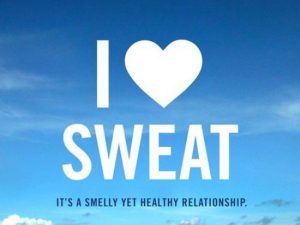 I saw one of my clients wearing a T-shirt that said, “Sweat Is Just Your Fat Crying,” and I loved it. While it isn’t scientifically accurate, who cares, it’s a fun phrase that helps you remember that when you work hard, you get results. However, just because you sweat, it doesn’t mean you’ve gotten the best workout or put in the effort required to shed those extra pounds and build muscle tissue. A lot of things can cause sweating. Some people sweat more than others normally. The room could be warm or you could have just eaten a super spicy hot pepper dish. You really don’t build muscle tissue in a steam room, but you’ll probably sweat more in there than you do in the gym.
I saw one of my clients wearing a T-shirt that said, “Sweat Is Just Your Fat Crying,” and I loved it. While it isn’t scientifically accurate, who cares, it’s a fun phrase that helps you remember that when you work hard, you get results. However, just because you sweat, it doesn’t mean you’ve gotten the best workout or put in the effort required to shed those extra pounds and build muscle tissue. A lot of things can cause sweating. Some people sweat more than others normally. The room could be warm or you could have just eaten a super spicy hot pepper dish. You really don’t build muscle tissue in a steam room, but you’ll probably sweat more in there than you do in the gym.
It’s fun to say, but not the way to gauge the effectiveness of a workout.
There’s a whole list of inappropriate ways to measure the merit of a workout. The amount of pain you feel is certainly one of those, just as the amount you sweat. That brings me to another infamous saying that’s echoed through the hallowed grounds of every gym, “No pain, no gain.” It’s yet another motivating phrase that trips off the tongue with ease to motivate the pikers and the whiners…but it’s not true. You don’t have to be in pain to make progress or to have a successful workout. You should notice tightness and muscle tiredness, but pain isn’t always part of the trail to success. In fact, sometimes pain, true pain, not just achy muscles, is a sign that something is wrong and you need to quit.
Measuring your heart rate is one method of gauging how hard you’ve worked your body.
To burn the most calories and get the maximum benefit, you need to have a workout that includes more intensity, especially if you’re using HIIT—high intensity training. The most objective way to measure intensity, since it’s different for every person, is to measure your heart rate. You want it to remain high for short periods, but not too high. Doing it without a device or monitor is almost impossible, so using a heart rate monitor is imperative for this measurement. You can calculate your maximum heart rate by subtracting your age from 220. If you’re 40, your maximum rate would be 180. Moderate exercise is between 50 and 70 percent of that number and vigorous is from 70 to 85 percent. For that 40 year old, if his or her hear rate is 90 to 126 the exercise is moderate and vigorous for anything above that up to 153.
There is a super simple way of establishing your aerobic workout.
Some people simply don’t want to mess with technology, although I love every bit of it from heart rate monitors to pedometers. For those people there’s a super simple way to establish whether the workout is their best effort. You can do this when you’re working out with a friend or if you’re not self-conscious, do it while you workout alone. It’s talking or singing as you workout. If you can easily converse, you’re only doing a light workout. A moderate workout allows you to talk, but not in long sentences, but an intense one only allows you to gasp out a few words at a time.
- Learn to let your body help you judge how hard you work. If you feel like you’re struggling and barely making it through an exercise, judge that as an intense workout.
- Know the signs of pushing yourself too hard. Shortness of breath, pain and having to cut the exercise short normally means you’ve used an intensity level that’s beyond your present fitness level.
- If you find your fitness level is too tough, it’s okay to back off a bit and then gradually build to that level as your body gets fitter.
- The calculations for heart rate were simplified. If you’re using a heart rate monitor, use the more complex ones that consider your resting heart rate.
